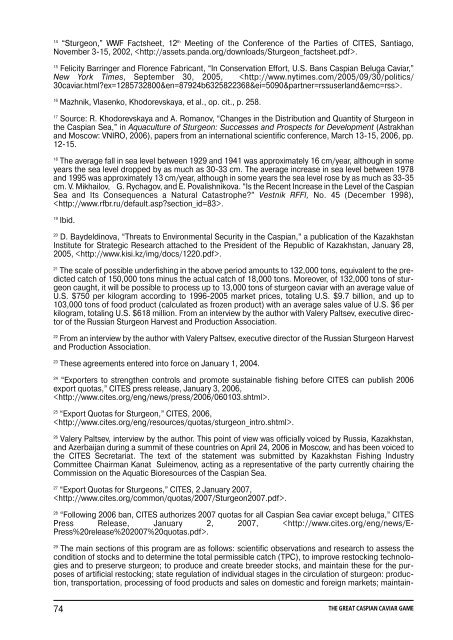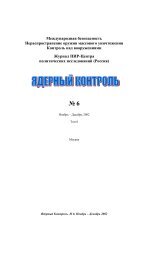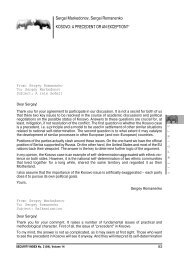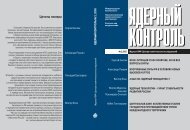Ekaterina Shadrina THE GREAT CASPIAN CAVIAR GAME
Ekaterina Shadrina THE GREAT CASPIAN CAVIAR GAME
Ekaterina Shadrina THE GREAT CASPIAN CAVIAR GAME
Create successful ePaper yourself
Turn your PDF publications into a flip-book with our unique Google optimized e-Paper software.
14<br />
“Sturgeon,” WWF Factsheet, 12 th Meeting of the Conference of the Parties of CITES, Santiago,<br />
November 3-15, 2002, .<br />
15<br />
Felicity Barringer and Florence Fabricant, “In Conservation Effort, U.S. Bans Caspian Beluga Caviar,”<br />
New York Times, September 30, 2005, .<br />
16<br />
Mazhnik, Vlasenko, Khodorevskaya, et al., op. cit., p. 258.<br />
17<br />
Source: R. Khodorevskaya and A. Romanov, “Changes in the Distribution and Quantity of Sturgeon in<br />
the Caspian Sea,” in Aquaculture of Sturgeon: Successes and Prospects for Development (Astrakhan<br />
and Moscow: VNIRO, 2006), papers from an international scientific conference, March 13-15, 2006, pp.<br />
12-15.<br />
18<br />
The average fall in sea level between 1929 and 1941 was approximately 16 cm/year, although in some<br />
years the sea level dropped by as much as 30-33 cm. The average increase in sea level between 1978<br />
and 1995 was approximately 13 cm/year, although in some years the sea level rose by as much as 33-35<br />
cm. V. Mikhailov, G. Rychagov, and E. Povalishnikova. “Is the Recent Increase in the Level of the Caspian<br />
Sea and Its Consequences a Natural Catastrophe” Vestnik RFFI, No. 45 (December 1998),<br />
.<br />
19<br />
Ibid.<br />
20<br />
D. Baydeldinova, “Threats to Environmental Security in the Caspian,” a publication of the Kazakhstan<br />
Institute for Strategic Research attached to the President of the Republic of Kazakhstan, January 28,<br />
2005, .<br />
21<br />
The scale of possible underfishing in the above period amounts to 132,000 tons, equivalent to the predicted<br />
catch of 150,000 tons minus the actual catch of 18,000 tons. Moreover, of 132,000 tons of sturgeon<br />
caught, it will be possible to process up to 13,000 tons of sturgeon caviar with an average value of<br />
U.S. $750 per kilogram according to 1996-2005 market prices, totaling U.S. $9.7 billion, and up to<br />
103,000 tons of food product (calculated as frozen product) with an average sales value of U.S. $6 per<br />
kilogram, totaling U.S. $618 million. From an interview by the author with Valery Paltsev, executive director<br />
of the Russian Sturgeon Harvest and Production Association.<br />
22<br />
From an interview by the author with Valery Paltsev, executive director of the Russian Sturgeon Harvest<br />
and Production Association.<br />
23<br />
These agreements entered into force on January 1, 2004.<br />
24<br />
“Exporters to strengthen controls and promote sustainable fishing before CITES can publish 2006<br />
export quotas,” CITES press release, January 3, 2006,<br />
.<br />
25<br />
“Export Quotas for Sturgeon,” CITES, 2006,<br />
.<br />
26<br />
Valery Paltsev, interview by the author. This point of view was officially voiced by Russia, Kazakhstan,<br />
and Azerbaijan during a summit of these countries on April 24, 2006 in Moscow, and has been voiced to<br />
the CITES Secretariat. The text of the statement was submitted by Kazakhstan Fishing Industry<br />
Committee Chairman Kanat Suleimenov, acting as a representative of the party currently chairing the<br />
Commission on the Aquatic Bioresources of the Caspian Sea.<br />
27<br />
“Export Quotas for Sturgeons,” CITES, 2 January 2007,<br />
.<br />
28<br />
“Following 2006 ban, CITES authorizes 2007 quotas for all Caspian Sea caviar except beluga,” CITES<br />
Press Release, January 2, 2007, .<br />
29<br />
The main sections of this program are as follows: scientific observations and research to assess the<br />
condition of stocks and to determine the total permissible catch (TPC), to improve restocking technologies<br />
and to preserve sturgeon; to produce and create breeder stocks, and maintain these for the purposes<br />
of artificial restocking; state regulation of individual stages in the circulation of sturgeon: production,<br />
transportation, processing of food products and sales on domestic and foreign markets; maintain-<br />
74 <strong>THE</strong> <strong>GREAT</strong> <strong>CASPIAN</strong> <strong>CAVIAR</strong> <strong>GAME</strong>








